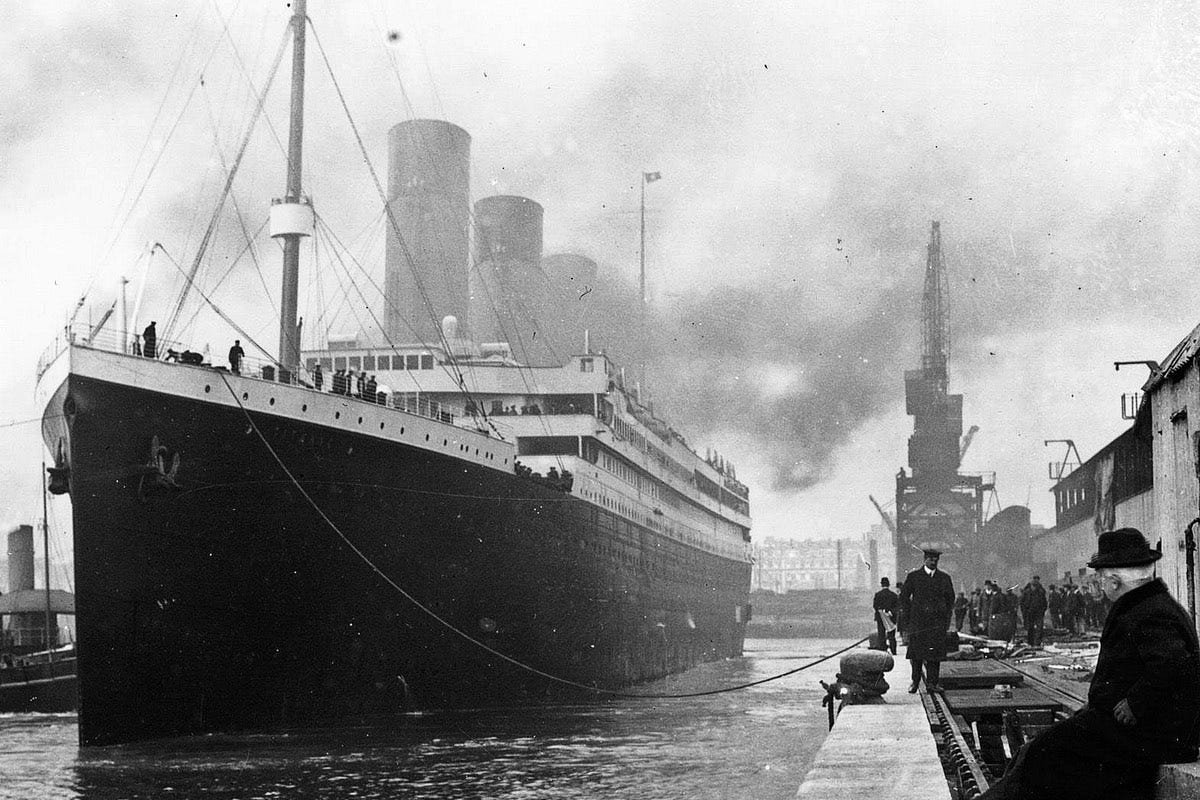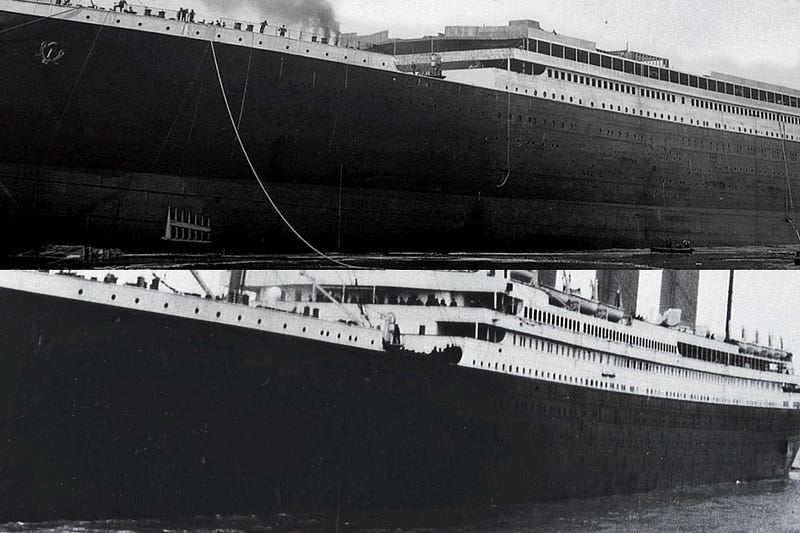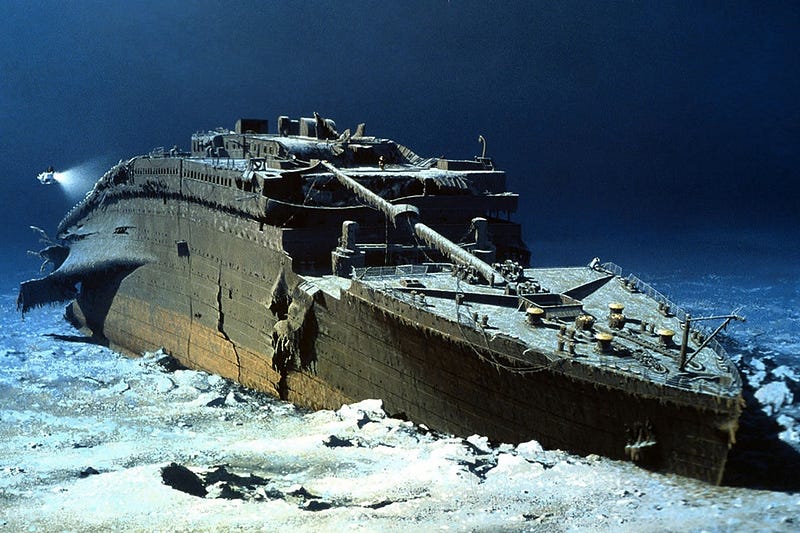
It is an historical irony that the most famous ship to ever sail was famous because it sank, but that was the case with the RMS Titanic. Then the world’s largest and most luxurious cruise liner, it hit an iceberg on its maiden voyage early on the morning of the 15th April 1912.
Within three hours, it had sunk to the bottom of the ocean, killing 1500 of the ship’s 2224 passengers and crew.
Titanic was one of three Olympic class ocean liners built at the Harland and Wolff shipyards in Belfast, the other two being the RMS Britannic and the RMS Olympic.

Within months of its launch in 1911, it had had two serious collisions, the second with Royal Navy cruiser HMS Hawke off the coast of the Isle of Wight causing serious structural damage to the Olympic’s keel and steel beams.
Some authors have suggested that the damage to the Olympic was more serious than admitted. In fact, it was virtually a write-off.
Repairs would be ruinously expensive, running into millions of pounds. The already troubled White Star Line was facing a potential financial disaster.

The Olympic, the theory goes, would be swapped with the Titanic and sunk in a staged accident. The Titanic, now disguised as the Olympic, would then carry on in service.
The two ships were essentially identical save for minor differences and were moored side by side in dry dock; the swap would entail nothing more elaborate that swapping a few nameplates and plaques.

Could it really have been the Olympic that sank in the Titanic’s place?
Evidence for
Portholes
Proponents of the swap theory have pointed out disparities in the number of portholes on the ships. The Olympic had 16 and the Titanic had 14.Photographs taken of the Titanic in dry dock show it with 14 portholes. But by the time of its doomed maiden voyage it now had 16, just like the Olympic.
Was this evidence that the ships had been swapped or just that they had added two extra portholes as part of aesthetic changes to the Titanic?

Rumours amongst crew
There was a nationwide coal strike during the launch of the Titanic.This had led to thousands of firemen, boiler stokers and greasers short of work. Yet despite this the Titanic struggled to find crew, with many men refusing to work on the ship at any price.
Rumours were circulating amongst the workers at Harland and Wolff that the ships had been swapped as part of an insurance scam, and Titanic was to be sunk
Did foreknowledge of the sinking of the Titanic frighten men off from wanting to work on the ship?
Despite the immense fanfare and hype that surrounded the Titanic launch, it was only just over half full when it left Southampton on its doomed voyage.
Did White Star want to minimise the number of passengers because it intended to scuttle the ship? Or had the rumours of the insurance scam spread outside of the shipyards?
Several last minute cancellations from high profile passengers certainly suggest some kind of foreknowledge.
Last minute cancellations
Many of the richest and most prestigious names in early 20th-century society were booked onto the Titanic.JP Morgan - the international financier who owned the White Star’s parent company, was due to travel on the Titanic but cancelled his trip a few days before the departure, claiming illness.

Industrialist Henry Clay Frick and his wife, banker Horace J. Harding and billionaire George Washington Vanderbilt - all connected to Morgan, were amongst several other prominent figures who cancelled at the last minute.
Californian
The SS Californian, also owned by JP Morgan, was a large passenger ship that was ultimately blamed for the loss of life on the Titanic.It behaved somewhat oddly around the time of the Titanic’s voyage.
Carrying no passengers, it steamed into the middle of the Atlantic, stopped and waited. It’s only cargo was 3000 woollen blankets and jumpers.
Edith Russell, a survivor of the sinking, was adamant that Titanic officers assured her the Californian was on its way.
Author Robin Gardiner suggests serious navigation errors lead to the Californian stopping in the wrong area - some 12 miles away from the Titanic.

The wreck
The wreck of the Titanic was discovered by Robert Ballard in 1985. Some evidence from the wreck supports the switch theory.The stamp 401, the id number used for the Titanic at Harland and Wolff, can be seen on the Titanic’s propeller.
However, some authors have suggested that the Titanic propeller was fitted to the Olympic during its repair following the collision with the Hawke.
If true, this would be strong evidence that the vessel on the ocean floor was really the Olympic.

The wreck appears to show some evidence of the grey paint used as an undercoat on the Olympic. The Titanic used black paint for its undercoat.
Lack of media scrutiny
Insurance scams and maritime fraud were common at the time of the Titanic’s sinking.Whilst it seems unlikely such a scam could be pulled off today, the lack of media coverage in 1912 makes it more credible.
Only one film survives of the Titanic and the photo record is also scant. With the two ships extremely similar, only the most eagle-eyed would ever have spotted the swap.
No comments:
Post a Comment